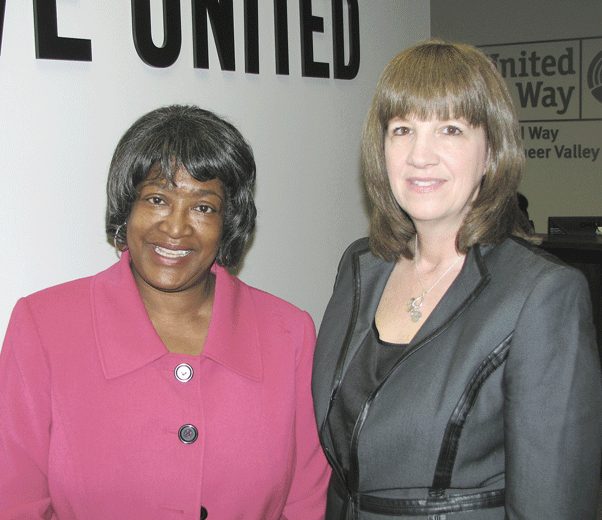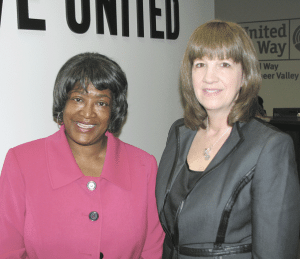
Engaging Concept
Local United Way to Form Women’s Leadership Council

Dora Robinson, left, and Kathy Dube say the timing is right for creation of a Women’s Leadership Council in Greater Springfield.
There was never any doubt about the benefits to creating such an organization, both within the community and for the women taking part, she explained, noting that there are now 130 such councils operating across the country in partnership with United Way chapters. And they have been effective in reaching out to women leaders in the community to engage and involve (the two words you see most often with respect to such groups) them in meeting the most pressing needs in a given area through donations of time, leadership, and financial support.
No, the only question facing the UWPV was whether a WLC, as they’re called, would duplicate the efforts of other women’s organizations in the area, such as the Women’s Fund of Western Mass. and the Professional Women’s Chamber of Commerce, said Dube, senior vice president and private banking officer with TD Bank and current chair of the UWPV board of directors. And some due diligence has determined that this would not be the case, she told BusinessWest, noting that while those groups and others do some of the things a leadership council would, they don’t do them all, and a council could fill what she described as a critical void.
“I felt there was a missing link between the professional women’s groups in Greater Springfield and the nonprofit world,” she explained. “And this is the perfect solution that pulls it all together. I don’t think there was a group that was doing all that a council does — fundraising, but also mentoring women in the process and getting actively involved in a key community need, and helping to put together a plan that solves an issue that we may have in Springfield.”
Thus, a 20-member “design team” is taking the concept for a leadership council from the drawing board to reality, said Dora Robinson, president and CEO of the UWPV and a member of that team. Some of the next steps in the process, and there are many, include everything from recruitment of members to creating an awareness campaign, to initiating discussions about possible projects for the council to undertake.
And there are intriguing examples to consider from across the country. In Cincinnati, for example, a WLC got directly involved in the plight of homeless women, doing everything from raising money for a new housing initiative to actually decorating the apartments. Meanwhile, the council affiliated with the United Way of Greater Chicago is involved in a partnership with the Young Women’s Leadership Charter School, and specifically an initiative known as its middle school academic intervention program, designed to ensure that girls stay on track to graduating from high school. And the council affiliated with the United Way of Northern New Jersey is helping to improve quality of live for those whose situation is described by the acronym ALICE: Asset Limited, Income Constrained, Employed.
In each case, the initiatives involve the three pillars of leadership council activity — financial support, volunteerism, and mentoring, said Dube, adding that the UWPV’s group will do the same in this market.
An Involved Process
Dube and Robinson both said that the catalyst for moving forward with the WLC came at a United Way conference in Nashville roughly a year ago.
One of the workshops was on women’s leadership councils, how they’ve evolved, and the many intriguing issues they were involved with, said Dube. “I left there thinking, we have to do this in the Springfield area.”
The reasons for doing so are obvious and many, she went on, but they come down to two: a strong base of professional women who want to get directly involved in the community, and an abundance of issues that could be addressed through donations of money, time, and talent.
“The timing is right for something like this in the Springfield area,” she told BusinessWest. “There are many issues to be addressed here.”
Robinson said the number of councils nationwide is growing steadily, primarily in response to national trends involving women, wealth, philanthropy, and effectively harnessing that power and influence. Among those trends:
• The Internal Revenue Service reported in 2010 that 2.5 million (38.8%) of the top wealth holders in the U.S. were women. These individuals had a combined net worth of almost $4.2 trillion. As of 2011, 50% of top wealth holders were women;
• In 2010, the Center for Women’s Business Research found that one in 10 women in the U.S. was a business owner, and their companies continue to grow at twice the rate of all firms; and
• Women live longer than men, meaning they will end up in charge of much of the $41 trillion expected to pass from generation to generation in the next 50 years.
“Given the fact that no two communities are alike with respect to the affluence and influence of women, the number of women-owned businesses, and opportunities for women to give and be involved, UWPV has a unique opportunity to build on the success of the national Women’s Leadership Council framework,” said Robinson. “We are committed to developing, designing, and implementing a program that is fitted to our local needs.”
And by that, she meant a council that can not only address recognized needs in the community, but also get women engaged and involved (there are those two words again) in not only creating a solution to a problem, but carrying it out.
Here’s how a women’s leadership conference works:
First, professional women are recruited to join. Membership involves an annual monetary donation, with those funds used to help finance projects the group will take part in. These donations vary with the market, said Dube, adding that while some councils assess $2,500 or more, the group in Hartford started with a few hundred dollars, opting to gradually increase that amount, a model that will likely be followed in this market.
Recruitment efforts are already underway on an informal basis, said Dube, adding that the design team will provide a solid base on which to build. One key to membership, she noted, is to make the council large enough to enable it to be effective, but not so large that members cannot be directly involved in a specific initiative.
“We want to make sure we know what we’re doing before we open it up to too many people,” she explained, adding that the initial goal will be 50 to 75. “But we have to make sure that those 50 to 75 are actively engaged in what we’re doing.”
The next big consideration is deciding what to do with the funds that are raised, or how to get the membership involved in the community it has been tasked with serving.
Existing councils are involved in a wide array of initiatives, as those examples from Cincinnati, New England, and Chicago clearly show, said Robinson, adding that a small yet effective council in Greenfield has been active with the broad issue of literacy and putting books in the hands of children.
And the Springfield-area group will be diligent in selecting projects that are impactful, but will also directly involve women in the group, said Dube, adding that many endeavors involving councils focus on helping women break from poverty.
“There have been discussions about doing a scholarship program for women who want to re-enter the workforce and need to go back to school to do that,” she noted. “And at the same time, we would weave into that mentoring and financial literacy training; that’s one possibility.”
The council will obviously look to avoid duplicating efforts already underway, said Robinson, noting, for example, that early childhood literacy, while an important issue, is being addressed by other groups, especially the Irene E. and George A. Davis Foundation.
“Initially, we’ll be looking for a project that has a start and a finish, so we can have some success,” Dube explained, citing the initiative in Cincinnati as one to emulate in that regard. “What was great about that project was that they recognized a need for housing, they went out and raised the money for it, and they did it — there was a start and an end, and now they’re moving on to another project.
“I think we’ll also try to find a project where we accomplish some objectives in a relatively short period of time, maybe a year,” she went on, “and then move onto another project that might be entirely different.”
Whatever direction the council takes, mentoring and direct involvement will be part of the equation, said Robinson, because those on the design team, and others who have expressed interest in the council concept have indicated that they want to do much more than write checks.
“There has been a fairly consistent theme around mentoring,” she noted. “Women want to be involved with other young women or girls in mentoring relationships. How that gets crafted into what we’re doing will be determined over the next few months.”
Impact Statement
The unofficial timeline for the council calls for a public launch sometime this fall, with planning and recruitment to take place in the months preceding.
But already there is considerable momentum for this initiative, which organizers believe has enormous potential to harness the desire among professional women in this region to donate more than money (although that’s certainly an important part of the equation) to the task of addressing some of the deeply rooted issues in area communities.
And addressing them by getting these women engaged and involved.
George O’Brien can be reached at [email protected]





